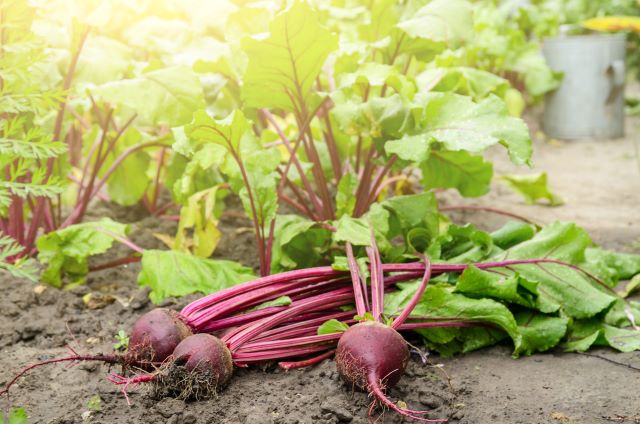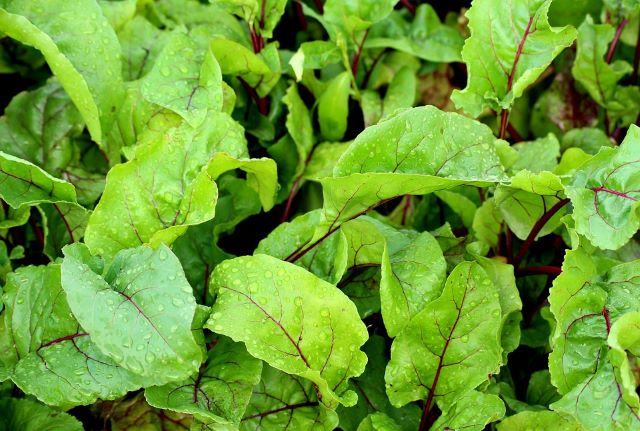Beets are easy to grow and maintain, but they are still prone to some growing issues. Yellow leaves may be the first sign of trouble with your beet plants. It’s important to understand what can be causing your beet leaves to yellow so you can stop the problem before it spreads and causes plant damage or failure.

Abnormal growth, insect infestations, and plant disease are just a few reasons why your beet leaves may be turning yellow.
To properly maintain the health of your beet plants, you should know how to recognize, treat, and prevent these issues from getting worse.
So read on to learn how to diagnose beet plant issues to enjoy a plentiful and delicious harvest each year.
Table of Contents
- Beet Plants Not Getting Enough Water Can Cause Yellow Leaves
- Overwatering Beet Plants Can Cause Yellow Leaves
- Insufficient Sunlight Makes Beet Leaves Turn Yellow
- Your Beet Plants Do Not Have Enough Sulfur
- Your Beet Plants May Have a Nutrient Deficiency
- Pest Infestation On Beet Plants Can Cause Yellow Leaves
- Your Beet Plant is Diseased Causing Yellow Leaves
- The Wrong Climate for Growing Beets Can Cause Yellow Leaves
Beet Plants Not Getting Enough Water Can Cause Yellow Leaves
When you first notice yellow beet leaves, you should check the soil for proper moisture levels.
Insufficient water is the most common cause of yellow leaves on beet plants, and it is also the easiest to identify. Beet plants love water, especially as plants reach maturity.
The amount of water your beet plant requires will depend on your climate. In the cooler weather of spring and fall, the soil will retain moisture longer than in the warmer weather.
As a general rule of thumb, you should provide your beets with at least one inch of water per week.
Overwatering Beet Plants Can Cause Yellow Leaves
It is also important to ensure your beet plants are not being overwatered. This can occur during periods of heavy rainfall or in garden beds with poor drainage.
Overwatering can cause yellow, droopy, or sagging beet plants and leaves.
If you notice these issues, take time to check the moisture levels of the soil. Overwatered soil will generally be darker in color – because it’s wet. So reduce or hold off watering your beet plants when you can see darker soil or feel moisture when you touch the soil.
Proper drainage in planters, pots, and raised garden beds is also essential to prevent overwatering of your beets. Pooling or soggy soil indicates that your plant bed is not draining properly. Check for clogged drainage holes or drill more holes to allow water to pass through the bottom of your pot.
Tips to Prevent Overwatering Your Beet Plants:
- Water your beet plants during daylight hours, mornings are best to allow the soil time to dry out a little during the day.
- Check for proper drainage.
- Water beets at the base of the plant, not the leaves.
- Do not water your beets if the soil is damp, soggy, or puddled.
Insufficient Sunlight Makes Beet Leaves Turn Yellow
Beet plants thrive in full sunlight, meaning they should be given at least six hours of direct sunlight per day. Sunlight encourages the roots to grow larger, which will allow the beet bulbs to become sweeter in taste. Ideally, beet plants should receive direct morning sun for optimum growth and development.
Although beet plants thrive in direct sun, they still offer advantages when placed in shade. Beet plants that grow in the shade will produce leafy greens that are edible and nutritious for side dishes, like salads.
You can choose the location of your plants depending on which part of the plant you prefer to eat.
Related reading: Eating Beet Greens With Recipe Ideas

Your Beet Plants Do Not Have Enough Sulfur
Soil rich in sulfur is essential for growing strong, large beet plants. Without sulfur in your soil, your beet leaves may yellow, shrivel, or become misshapen. You may also notice spindly stems or stunted growth on new growth. Sulfur helps the beet plant better absorb other nutrients, like nitrogen, in addition to being responsible for making proteins.
Benefits of Sulfur
- Increases crop yield
- Improves quality, taste, and aroma of beets
- Fights diseases
- Balances the pH of your soil
Mix sulfur flour or powder into the first three inches of your soil at the beginning of each growing season. Many fertilizers contain sulfur and for an all-purpose organic edible garden fertilizer, l really like this one.
Adding these sulfur-rich products into your garden will improve the development of your beet plants, leaving you with delicious vegetables at the end of the season.
Your Beet Plants May Have a Nutrient Deficiency
Well-balanced and highly nutritious soil is essential for healthy beet plant growth. Your beet plant soil needs more than just sulfur. It should also contain nitrogen, phosphorus, boron, and potassium.
While nitrogen is responsible for growing strong, leafy greens, you also want to be sure to treat the root of this plant. Beets are root vegetables, so you will want to choose a fertilizer that reaches all of this plant’s needs, from root to leaf.
To replenish your soil with proper nutrients for your beet plants, an organic edible garden fertilizer is beneficial. Fertilize your beet plants at the beginning of the growing season to encourage healthy growth.
While it is important to start with nutrient-rich soil, with the addition of healthy compost, you also need to keep the soil rich through the growing season. To determine whether your soil needs to be fertilized, you can perform a soil test using a gauge like this one.
Pest Infestation On Beet Plants Can Cause Yellow Leaves
Aphids commonly attack the leaves of the beet plant, causing them to yellow and become infected. Although aphids are extremely small in size, they can cause extensive, or even fatal, damage to your leafy plants. They will suck the nutrients from the beet leaves of your plant. If undetected, this can lead to plant disease and failure of the beet plant.
If aphids have been feeding on your beet leaves, you will notice a few signs, such as:
- Sickly yellow leaves
- Sticky residue on leaves
- Curled or twisted leaves
To remove aphids from your beet plants, you can spray the leaves with a blast of water from the hose. If issues persist, treat with a safe insecticide until the bugs are no longer a threat. I favor horticultural neem oil or insecticidal soap which are safe to use on edible plants.
Your Beet Plant is Diseased Causing Yellow Leaves
Beet plant diseases often start with yellowing leaves, and if untreated, they can lead to plant failure. When unnoticed, some plant diseases can cause the entire crop to be inedible and fail. It is important to diagnose and treat these issues quickly to prevent damage to your beet plants.
Common Diseases that Affect the Beet Plant:
- Curly Top – A common pest of the beet plant, leafhoppers, may spread Curly Top throughout your beet crops. This disease is characterized by yellow, curling leaves. Over time, it can stunt growth and cause plant death if untreated. It will also result in discoloration of beet bulbs, which may affect taste.
- Beet Western Yellows – This virus is likely caused by aphids, which feed on the beet plant. It first causes the older leaves to start yellowing. The yellowing will continue until the oldest, lowest leaves are all yellow. This disease will cause the plant to also become thick and brittle.
- Beet Yellow Stunt – As the name suggests, Beet Yellow Stunt can cause stunted growth and deformities on your beet plants. To diagnose your beet plants for this disease, look for small yellow dots on the tops of your leaves. In addition to causing yellow spotting, this disease will also cause your beet plant to look unbalanced and deformed in shape.
- Black Root Rot – Beet plant yellow leaves can also be indicative of Black Root Rot. Other tell-tale signs of this issue include drooping leaves and stunted growth. Although the leaves will yellow, the damage caused by this disease is mainly in the roots. Roots become dry, black, and shriveled. This will make the beet bulbs inedible.
How to Prevent and Treat Disease in Your Beet Plant
There are a few ways to prevent the development and spread of disease in your beet plants.
Frequent Removal of Dead, Diseased, or Decaying Plant Debris
Routine weeding of your garden can prevent the spread of disease and maintain healthy, attractive beet plants. This includes removing any plant debris, intrusive plant species, dead or decaying leaves or roots, and other contaminants from the area. Keeping your garden beds clean is essential for disease prevention and maintenance.
Treat with Insecticide
Once you notice disease is present, you should act quickly to treat your beet plants. Prevent further decay by treating with an organic and safe insecticide. Popular insecticides include neem oil, homemade soap blends, insecticidal soap, and essential oils.
Crop Rotation
Rotating plants in your garden encourages soil health, optimizes nutrients, and repels pests and insects. Pests and insects can make permanent residence in the soil of their favorite plants. Rotation is the best way to combat this from happening and prevent pest- or fungus-related diseases.
Proper planting and crop rotation of beet plants should be taken into consideration to ensure a bountiful and healthy harvest.
Proper Soil Preparation
At the beginning of each gardening season, it is essential to prepare the soil for new beet plants. This involves removal of any old, decayed plant roots or debris, and adding compost or nutrient-rich soil at the time of planting.
The Wrong Climate for Growing Beets Can Cause Yellow Leaves
Finally, consider the climate you are growing your beets in. As a cool-season crop, beets grow best in temperatures of 50-70°F (10-21°C). If temperatures exceed or dip below this range, beet leaves can suffer and turn yellow.
For most of us, beets grow well through early spring, late summer and into early fall. This way your beet crop will avoid being grown in the heat of summer and the freezing cold of winter.
Further Reading:
- Why Are My Beets So Small? Answered!
- How to Grow Beets: Planting, Growing and Harvesting Beetroot
- Why Are My Beets Dying? Causes and Solutions
- 13 Beet Pests Eating Your Crop (With Organic Solutions)
- Why Are My Sweet Potato Leaves Turning Yellow?
- Why Is My Broccoli Turning Yellow? (And how to fix it)
- Why Are My Kale Seedlings Turning Yellow? Causes and Solutions
